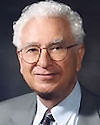Gell-Mann had tried to brute-force his way into a suitable group with up to 7 generators
during his 1959-60 stay at the Collège de France,
especially in the fall of 1959.
In the Fall of 1960, Dick Block
(Richard Earl Block,
b. 1931, Ph.D. 1956)
was a young assistant professor of mathematics at Caltech, who had recently
completed his Ph.D. dissertation on Lie Algebras at
Chicago,
under A. Adrian Albert (1905-1972).
Block pointed out to Gell-Mann that he was re-inventing the wheel:
The problem was about simple Lie groups in canonical form and the solution was well-known...
Therefrom came Gell-Mann's interest in SU(3) which worked beautifully
[sic]. Gell-Mann was the first to call gluons
the 8 vector bosons associated to the above generators
(the word itself had been introduced by
Edward Teller (1908-2003) in an unrelated context).
At the time, George Zweig (1937-) was working at CERN,
just after getting his doctorate, on a similar
scheme based on four aces rather than three quarks.
Yuval Ne'eman (1925-2006)
also came to the same conclusion around the same time, as he obtained his
Ph.D. under Abdus Salam (1926-1996)
at Imperial College London
(Ne'eman was military attaché at the nearby Israeli embassy).
The discovery of the W-, in February 1964,
can be construed as the experimental confirmation of SU(3) symmetry in hadrons.
Both Gell-Mann and Ne'eman were involved.
This paved the way for the quark proposal shortly thereafter.
Noble Eightfold Path (Buddhism)
|
Gell-Mann matrices
Groping for SU(3) (4:02)
by Murray Gell-Mann (1998).
Most-Cited Rewritten Eightfold-Way Paper of 1962 (3:53)
by Murray Gell-Mann (1998).
Numericana : Pauli matrices
| Laws of Nature




